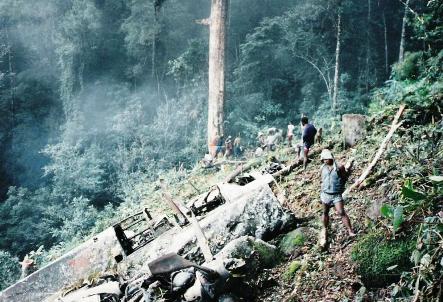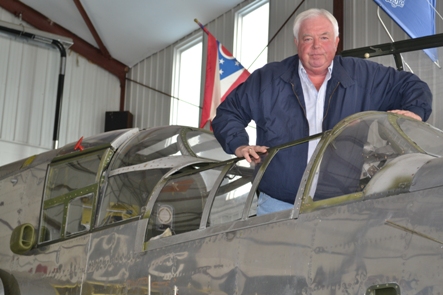When the world's only flyable Northrop P-61B Black Widow returns to the skies a few years from now under the command of Mid-Atlantic Air Museum director Russ Strine, it will do so at an appropriately named airport - the Carl Spaatz Field, in Reading, Pennsylvania. That's because US Army Air Force general Carl Spaatz, born in nearby Boyertown, Pennsylvania, will be just as integral to this amazing first flight feat as Strine.
The story goes that Spaatz, after witnessing the German Luftwaffe's night-time raids on London in 1940, returned to Washington with the specifications for the world's first specialised night-fighter aircraft scribbled on a napkin. Those specifications, under the care of aerospace luminary Jack Northrop and team at his new Northrop Aircraft company, became the P-61 Black Widow soon afterwards.
 |
|---|
| © MAAM The P-61 was painted black to avoid searchlights |
Pressed into service in the waning years of World War II, and painted black to avoid ground-based spotlights, the Black Widow carried on-board radar that let it sneak up on enemy aircraft at night. Crews could approach the prey in stealth, coming in underneath the intended target to identify it by eye as friend or foe, the latter being blown out of the sky with the P-61's four 50.cal machine guns and four 20mm cannons after the fork-tailed twin backed off and sighted in.
Strine and his father, Gene "Pappy" Strine, and 50 volunteers at the 1,200-member Reading-based museum, have been working for more than 30 years to restore what will eventually be the only flying example of the fighter Spaatz envisioned more than 70 years ago. Once certified in the experimental category following flight tests, the P-61B will begin flying airshows around the US east coast, and Strine says demand is already soaring. Three other P-61s exist as non-flying models; two in the US and one in China.
How P-61B-1 serial number 42-9445, built in August 1944, came to be perched partially assembled in a corner of Strine's museum hangar in rural Pennsylvania is fascinating.
 |
|---|
| ©JOHN CROFT |
| P-61B in right rear corner of MAAM hangar |
As Strine tells it, Pappy first learned of a low-time wrecked P-61B model near the 7,000ft peak of Mount Cyclops in New Guinea in 1979, from a Confederate Air Force (now known as the Commemorative Air Force) B-29 crew while he was flying the air show circuit as a B-25 co-pilot. The non-fatal prang had occurred two days after the 550th night fighter squadron based at Hollandia airfield had received the aircraft in January 1945.
NEVER RECOVERED
Because of its precarious location on steep slopes and in jungle, the aircraft was never recovered. Despite years sitting in a tropical climate, corrosion had not claimed the airframe, despite the AAF being so hot to get the night fighter that Northrop did not proof the metal against corrosion (Strine says fighter aircraft at the time were only expected to have a life of 90 days anyway).
 |
|---|
| ©MAAM |
| Black Widow on Mount Cyclops |
Visions of recovering and restoring that aircraft took hold, with the Strines ultimately creating the museum in 1980, largely as a ploy to gain enough letterhead recognition to get the Indonesian government, the de facto owner of the crashed aircraft, to assign them the rights to the hull. After four years of trying, the Strines gained approval and for six years, from 1984, mounted eight expeditions to Indonesia to bring back the parts and pieces to Reading, where restoration started in April 1991. "We had no clue how difficult and involved it was going to be," reflects Strine.
Meanwhile, the museum had become more than a letterhead, with 19 aircraft on its roster. "People came to us wanting to get rid of aircraft," Strine said, "possibly because we were the first museum in the area and we fulfilled a need." Number one was a federal-surplus R4D, the US Navy equivalent of the Douglas DC-3.
Today the museum has 87 aircraft, including a Martin 404, Vickers Viscount and Convair 580. Half of the aircraft are restored and half are stored either indoors or outdoors, a problem Strine hopes to address with a new hangar. Eleven of the aircraft, including the museum's B-25 "Briefing Time", take part in the summer air show circuit in the mid-Atlantic area. Strine says the museum still takes in aircraft about three aircraft per year, usually those that are in some way unique. The museum's banner event is its annual World War II re-enactment weekend that draws 30,000 visitors to the airport. "It's been a godsend," says Strine of the event, now in its 22nd year.
Attendance will likely spike, perhaps as soon as 2014 if the Black Widow graces the summer skies.
Strine doesn't need a written list to tick off the remaining to-dos to finish the Black Widow. His volunteer artisans have "just about" finished the elevator and have started rebuilding the first of two rudders, both of which have required total disassembly. The wings (outboard of the engines) will be "last big item" to rebuild. One was sheered in half by an ironwood tree during the crash and the other has a dented leading edge, Strine says. Both wings, in addition to an internal cleaning and corrosion treatment, will likely get new front and rear spars. "Since I'm going to fly it and because I want it to be around for another 100 years, we're putting in new spars," says Strine.
 |
|---|
| ©JOHN CROFT |
| Russ Strine in the cockpit of the soon-to-be-completed P-61B |
In parallel, the museum is getting ready to embark on a fundraising effort to buy a second four-blade Curtiss Electric propeller. Strine had earlier acquired a new overhauled prop for $45,000. Last will be the two 2,250hp (1,680kW) Pratt & Whitney R2800-65 engines, components Strine wants to wait as long as possible to procure. "I don't want them to sit for years not being run," he says.
Though Strine has both of the original engines, he says neither can be overhauled. He found one new engine core, part of a quick engine-exchange kit that included engine, mount, cowling and cowl flaps, in Fargo, North Dakota. That engine will need to be overhauled before being pressed into service, and a second will have to be found.
Strine is to be the only captain for the Black Widow, as he is for the museum's B-25. He's not worried about first flight, despite not having any P-61 pilots on the museum roster or any on his speed-dial. "The aircraft is basically a B-25," he says. "It has virtually the same speeds in liftoff, cruise and approach, but with a lower stall speed (70mph)." He says parts commonality with the B-25 include the Bendix landing gear (though the main gear is turned outward for the P-61 versus inward for the B-25) and same hydraulic system.
Strine flew the B-25 for 27.5h last year and 22h the year before, and expects the P-61 to fly about the same amount, possibly more at the start of its new life if the museum launches a national tour.
He won't guess how many hours of blood, sweat and tears have gone into N550NF to date, but he estimates the museum has spent about $900,000 on the project so far and has about that much more to go.
Strine is sure the plane is worth much more than that, based on a $6.5 million offer he received from a collector. "That money sounded good," he says, but, ultimately, he decided to stay the course. "That's the project that started the museum," he says.
Source: Flight International























